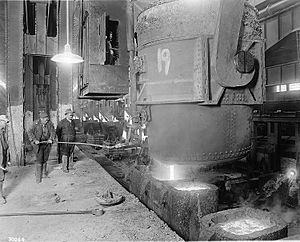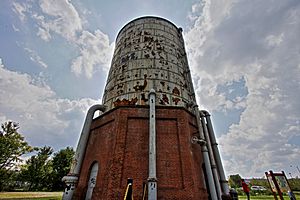Homestead Steel Works facts for kids
The Homestead Steel Works was a very large factory that made steel. It was located along the Monongahela River in Homestead, Pennsylvania, in the United States. This huge factory grew a lot in the 1800s. It had its own coal and iron mines, a long railway, and even ships to bring materials. The Homestead Steel Works is also famous for a big fight between the workers and the company. This event is known as the Homestead strike of 1892.
Contents
A Look Back at Homestead Steel Works
The Homestead Steel Works first started building in 1881. Just two years later, in 1883, a man named Andrew Carnegie bought the factory. Carnegie was a Scottish immigrant who became very successful in the steel business. He added Homestead Steel Works to his company, the Carnegie Steel Company. For many years, Homestead Steel Works was the biggest steel factory in the world. It made more steel than any other factory in the Mon Valley area.
The Homestead Strike of 1892
Over the years, there were many disagreements at the factory. Workers and the company argued about pay, working hours, and contracts. These arguments led to the famous Homestead strike. This strike began on June 30, 1892. It was a time when the company locked workers out, and the workers refused to work.
On July 6, 1892, a big battle happened between the striking workers and private security guards. This fight was one of the most violent events in U.S. labor history. In the end, the workers' union lost, and it became much harder for steelworkers to form unions.
In 1896, Andrew Carnegie built the Carnegie Library of Homestead in nearby Munhall. Some people believe he built it as a way to make up with the striking workers. However, Carnegie had actually planned to build the library years before the strike.
Later Years and Closure
In 1901, Andrew Carnegie sold his entire steel business, including Homestead Steel Works, to U.S. Steel. The factory continued to grow and improve. In 1906, the company announced big plans to upgrade and expand the plant.
During World War II, the factory was very busy. It employed as many as 15,000 people. A designer named William J. Gaughan helped create computer systems to make the factory's operations more automatic. He also collected many photos and papers about the company's history.
The Homestead Steel Works finally closed in 1986. This happened because of a big problem in the steel industry in the United States. Many steel factories faced difficulties at that time.
What's Left Today
Most of the steel works were taken down after it closed. However, a few parts of the old factory still remain. For example, twelve smokestacks can still be seen in the middle of the area.
Today, part of the land where the factory once stood is now The Waterfront. This is a large outdoor shopping center that opened in 1999.
Images for kids
-
A Gantry crane on the Monongahela riverbank. It was used for loading barges with steel.




